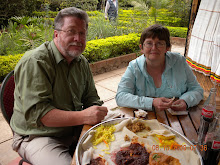The animals and the landscape of the Maasai Mara were magnificent, but by far, I most enjoyed meeting the Maasai people. We were privileged to visit one of their villages. Maa is their language and "sai" means "the people." Young single men, morani protect the village and their livestock. These young warriors stand guard and defend against marauding predators. They wear red robes so that they can recognize each other from a distance and frighten predators who have come to understand that the men in those robes are dangerous.

The young warriors dance and sing to welcome us.
These young men show their tribal membership by either piercing their ears with sharp knives, burning tribal scars into their upper arms or by knocking out the middle two lower incisors. Some young men choose to lose the teeth in order to better fit in with modern society.
 Third from the right, Peter, the chief's son, leads the warriors in a jumping contest. The young men leap to show their strength and desirability to young Maasai maidens.
Third from the right, Peter, the chief's son, leads the warriors in a jumping contest. The young men leap to show their strength and desirability to young Maasai maidens.
These bold young men began young herding goats and sheep and learning how to defend themselves and their flocks. Once they are of age, they begin standing guard for the village and their precious livestock, each armed with a rungu (a war club), a finely balanced spear and a "Roman" two-edged sword. I witnessed one young Maasai in a larger city, attired in blue dress shirt and dress pants and a sweater vest. He rode a bicycle and had his Roman sword strapped to his side.

One young man bore the scars of a lion attack on his throat and neck. His fellow warriors rescued him, one literally pulling the lion away by its tail.
Once a young man marries and becomes a family man, he no longer has these dangerous duties.

Jim dances with the young warriors.
 Building a fire.
Building a fire. The beginnings of a new home. It will be plastered with cow dung and mud. The parents will sleep on a bed made of springy branches and covered with cowhide. The children will have a small bed in an adjoining section.
The beginnings of a new home. It will be plastered with cow dung and mud. The parents will sleep on a bed made of springy branches and covered with cowhide. The children will have a small bed in an adjoining section.
A small room for new calves inside a home.

Drying laundry. The young Maasai men construct a formidable fence of densely packed branches for their villiage and one interior fence (boma) with thorny acacia branches to protect their flocks.
 Beginnings of new village, with fence enclosing the families and precious livestock.
Beginnings of new village, with fence enclosing the families and precious livestock.
 A sausage tree provides containers for milk, sometimes mixed with blood from cows.
A sausage tree provides containers for milk, sometimes mixed with blood from cows. Precious Maasai cattle--their wealth.
Precious Maasai cattle--their wealth.A young boy tending sheep and goats.
 I am an African boy
I am an African boyAnd my father and mother named me Sahoi
My tribe is nomadic
And our moving around is quite systematic
I know every bush and tree apart
And I know when the hungry hounds howling will start
I run barefoot through hot sand;
I live in a desert; a barren dry land.
My meals are normally blood, milk and meat
And getting good three times a day is a treat
On the night of full moon,
War cries were heard in the distance, meaning our enemies were
coming soon
I leapt from the ground,
As did everyone else, and moved toward our precious cows
without making a sound.
My father brandished a club,
And I stood, teeth clenched, like a young lion cub.
Our enemies were surprised,
When they saw a line of warriors standing on a low rise.
Now under the full moon light,
I saw a sad sight to see, of men who bravely came to fight.
Most of our enemies have now run away,
Some were killed, we'll move their bodies another day.
Some day I'll be a warrior too,
I won't act like a foolish child and everything I learn will be new.
I am an African boy,
And my father and mother named me Sahoi.
Written by Alanna (now a freshman) during 8th grade
Both her parents and grandparents have ministered
to the Maasai.

A lone Maasai travels through town.

No comments:
Post a Comment